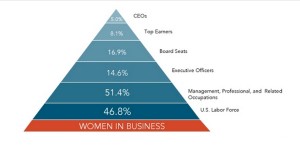Recently I was asked to participate in a panel discussion at a business breakfast event about women’s leadership. In conversations with the moderators, they asked, “So how far has women’s leadership really come?” And last week, I was asked, “Are there really any barriers left for women?” So here is where things stand.
There is no doubt that significant progress has been made in terms of diversity in the workplace. In the 1950s, women represented 30% of the workforce; today they represent almost half. Nationally, women have outnumbered men in college for years, and also outperform men academically. In professional occupations, women actually squeak out a slight majority at 51%. But once we start looking up the leadership ladder, the picture changes dramatically. The chart below from Catalyst visualizes the challenge: women are in the workforce, but are significantly underrepresented at the higher levels. They represent fewer than 17% of board seats, 15% of executive positions, and 5% of CEOs. The picture in other arenas, such as politics, is not much rosier. Women represent 19% of U.S. Congress, 10% of governors, and 18% of mayors. And, of course there is the gender pay gap to consider, which is currently at about 78¢.

The reasons behind the leadership and pay gaps are many and complex. Some argue it’s discrimination, or that workplace policies and culture are not aligned with women’s lives. The barriers are no longer absolute or insurmountable. Rather, women’s choices, actions, and paths to success are, in Alice Eagly’s words, a labyrinth. Whatever the reasons, the gaps are indeed indisputable. The argument for progress is not just about equal rights; it’s smart business. Why should corporate America care? Having more women on boards results in better financial outcomes. Forward-thinking organizations are realizing this, and are working on developing their leadership pipeline for all employees, male and female. If you need another reason, consider that women represent half of the population, and reportedly control up to 85% of consumer spending, so having women equally represented in decision-making helps to reflect the marketplace.
The short answer to, “How far have we come?” is, “Not far enough.”

